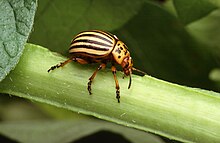Chrysomeloidea
| Chrysomeloidea | |
|---|---|

| |
| Colorado potato beetle, Leptinotarsa decemlineata | |
| Scientific classification | |
| Domain: | Eukaryota |
| Kingdom: | Animalia |
| Phylum: | Arthropoda |
| Class: | Insecta |
| Order: | Coleoptera |
| Suborder: | Polyphaga |
| Infraorder: | Cucujiformia |
| Clade: | Phytophaga |
| Superfamily: | Chrysomeloidea Latreille, 1802 |
| Families | |
|
Cerambycidae - long-horned beetles | |
The Chrysomeloidea are an enormous superfamily of beetles, with tens of thousands of species. The largest families are Cerambycidae, long-horned beetles, with more than 35,000 species, and Chrysomelidae, leaf beetles, with more than 13,000 species.[1]
Overview
[edit]The Chrysomeloidea, like all other Phytophaga, typically have the fourth tarsal segment reduced and hidden by the third segment. Several species in these two families are important plant pests. The spotted cucumber beetle is a serious pest of vegetables and is a very common insect on all sorts of flowers. The Colorado potato beetle, Leptinotarsa decemlineata, attacks potatoes and other members of the Solanaceae. The Asian long-horned beetle is a serious pest of trees where it has been introduced. [citation needed]. It seems almost evident that during the Jurassic and the Cretaceous the Chrysomelidae were pollen feeders and then they became external and later on internal feeders on or in leaves, buds, twigs and roots.[2]
Some authorities in the past have suggested removing the Cerambycidae and related families (Disteniidae, Oxypeltidae, and Vesperidae) from Chrysomeloidea to create a separate superfamily "Cerambycoidea" (e.g.,[3]), but in the absence of evidence to support the monophyly of the resulting groups, this proposal has not been widely accepted by the scientific community.[4][5][6][7]
References
[edit]- ^ "Coleoptera". GBIF, Global Biodiversity Information Facility. Retrieved 2022-07-02.
- ^ Jolivet, Pierre (1988), Jolivet, P.; Petitpierre, E.; Hsiao, T. H. (eds.), "Food Habits and Food Selection of Chrysomelidae. Bionomic and Evolutionary Perspectives", Biology of Chrysomelidae, Series Entomologica, Dordrecht: Springer Netherlands, pp. 1–24, doi:10.1007/978-94-009-3105-3_1, ISBN 978-94-009-3105-3, retrieved 2020-10-17
- ^ Švácha, P.; Danilevsky, M.L. (1990). "Cerambycoid larvae of Europe and Soviet Union (Coleoptera Cerambycoidea). Part I.". Entomologia Generalis. 15 (3): 202.
- ^ Nie, Ruie; Vogler, Alfried P.; Yang, Xing-Ke; Lin, Meiying (2020). "Higher-level phylogeny of longhorn beetles (Coleoptera: Chrysomeloidea) inferred from mitochondrial genomes". Systematic Entomology. 46 (1): 56–70. doi:10.1111/syen.12447. S2CID 225359376.
- ^ Bouchard, Patrice; Bousquet, Yves; Davies, Anthony E.; Alonso-Zarazaga, Miguel A.; et al. (2011). "Family-group names in Coleoptera (Insecta)". ZooKeys (88): 1–972. doi:10.3897/zookeys.88.807. PMC 3088472. PMID 21594053.
- ^ "Chrysomeloidea Report". Integrated Taxonomic Information System. Retrieved 2022-07-02.
- ^ "Chrysomeloidea superfamily Information". BugGuide.net. Retrieved 2022-07-02.
Bibliography
[edit]- Löbl, Ivan; Smetana, Ales, eds. (2010). Chrysomeloidea. Brill. ISBN 978-90-04-26091-7.
- Haddad, S.; McKenna, D.D. (2016). "Phylogeny and evolution of the superfamily Chrysomeloidea (Coleoptera: Cucujiformia)". Syst Entomol. 41 (4): 697–716. doi:10.1111/syen.12179. S2CID 87055542.
External links
[edit] Data related to Chrysomeloidea at Wikispecies
Data related to Chrysomeloidea at Wikispecies Media related to Chrysomeloidea at Wikimedia Commons
Media related to Chrysomeloidea at Wikimedia Commons- "Chrysomeloidea". Atlas of Living Australia.
